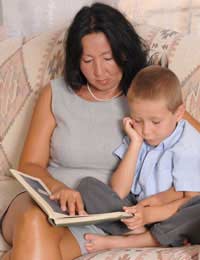Reading: Traditional And Fantasy Stories

At Key Stage 1 the National Curriculum states that your children's reading should cover many different genres; for example stories with familiar settings, stories from a range of cultures and traditional and fantasy stories.
What are Fantasy Stories?
Children have always been fascinated with fantasy stories. In fantasies, people and animals live in a make-believe world. A fantasy can begin realistically or contain some bits of reality to make them more believable to the reader. A key feature of this genre is the use of a ‘doorway’ or ‘portal’ that connects the ‘real’ world with the fantasy one. A successful fantasy story is one that draws in the reader and makes them almost believe that it could happen.Nursery rhymes, fairy tales and folk tales are all fantasy stories where children can enter the world of make-believe while reading. Children of all ages love to read about imaginary worlds and talking animals, toys coming alive, and characters doing the impossible. Fantasy allows children to stretch their imaginations and can transport a child beyond their own world to magical places where fantastic characters can be met and the impossible can be achieved.
Fantasy stories can explore a variety of themes. They can teach a child to understand the differences of others, tolerance of other people and places and bring about openness toward new experience. Fantasy puts the world into perspective in a way that "realistic" literature rarely does.
The roots of fantasy stories and their themes lie in traditional stories. For instance the rabbit hole in the traditional story of Alice in Wonderland, the wardrobe in The Lion, The Witch and the Wardrobe or the troll living under the bridge in Three Billy Goats Gruff.
What are Traditional Stories?
Traditional stories are those that belonged to the oral tradition of storytelling and were handed down by word of mouth through the generations and across different cultures. Traditional stories include folk or fairy tales, myths, legends or fables. These stories often contain contrasts in theme, such as that between good and evil, rich and poor, wisdom and foolishness, beauty and ugliness and so on.Reading with your Child
When reading fantasy or traditional stories with your child you will have many wonderful opportunities for discussion, as many stories embody similar struggles and emotions that your child may experience. Many stories contain important messages about how they should behave and the consequences of not acting properly. Traditional and fantasy stories are also an excellent way of teaching culture and history while improving reading skills and vocabulary.Make the most of books your child brings home from school. Read them, or parts of them, yourself and talk about them with your child. You don’t have to wait for them to bring books home from school though. There are many fantastic fantasy and traditional books available at your local library so make use of it if possible.
Read with your child as often as possible and approach reading with enthusiasm and a positive attitude. Remember that all children develop their reading skills in different ways. Whether your child is a confident reader or a more hesitant one, try to respond appropriately to their needs and let them read at their own pace.
- Speaking and Listening: Storytelling
- Science: Living Things
- Spelling And Grammar
- Learning About Writing
- Learning about Shapes
- Citizenship: Money
- Using Flashcards
- RE: Bible Stories
- PSHE: Good Manners
- Infants: Recognising Colours
- Numbers: Number Bonds
- Citizenship: Bullying
- History: Famous Inventors
- ICT: Word Processing


Re: English Literature: How to Write a Poetry Essay
New Member Introduction – Happy to Join the Community
Re: Speaking and Listening: Storytelling
nice
Re: Starting a Homework Club
Hi I resently start with a homework club do I need to be rgister at socail workers and go to all that proces please need some at advice
Re: Starting a Homework Club
I'm trying to start a homework club business in my community. I wish I could get a mentor who would assist me step by step to achieve…
Re: Starting a Homework Club
Hello, I’ve recently opened my own private after school homework club but I could do with a lot of guidance (Perhaps a mentor) to help…
Re: Starting a Homework Club
Thank you for your info I set up one in my church as I see many struggling maths and science students From just a few we have grown…
Re: How Much Homework Should Your Child Be Getting?
My daughter has just started year 7. She can get 2-4 pieces of home work per day each from 30-45 mins…
Re: How Much Homework Should Your Child Be Getting?
My 8 year old (year 3) daughter gets almost no homework. We are ,and always have, pushed her to succeed,…
Re: How Much Homework Should Your Child Be Getting?
My daughter moved to secondary school in Wales in January 2019. Since then she has had one or two pieces…
Re: Keeping a Homework Diary
I love school I have been told I could go on this app to do homework ??!!